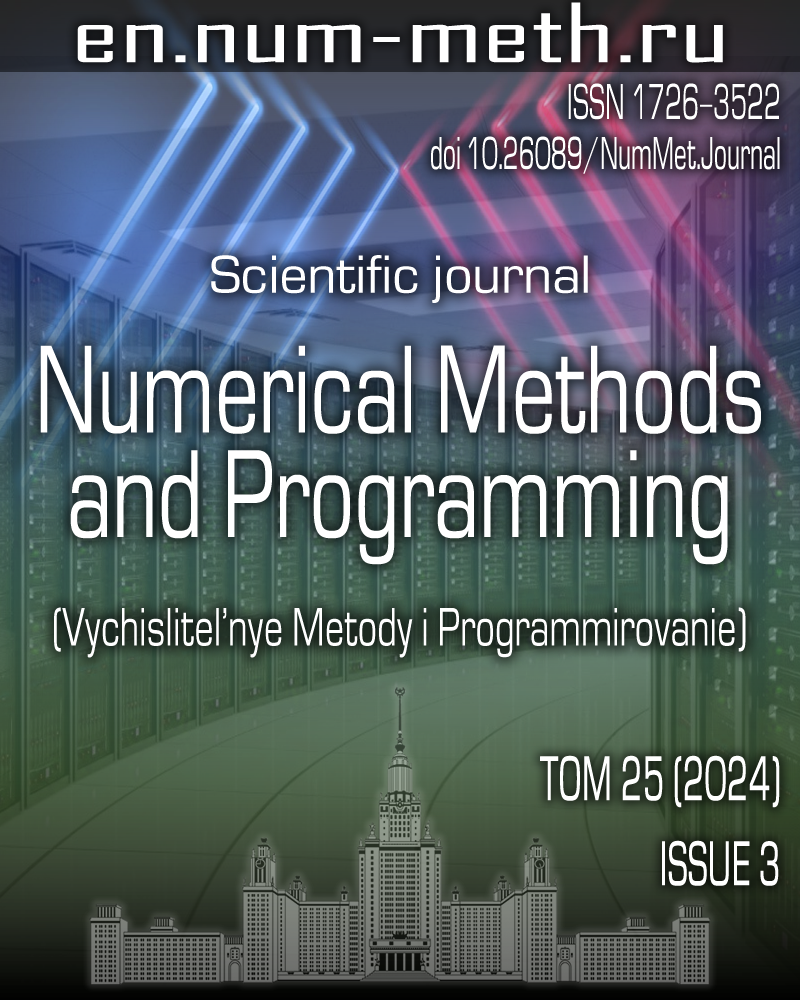DOI: https://doi.org/10.26089/NumMet.v25r325
Development of an efficient algorithm for computing the magnetic field intensity in a plasma trap
Keywords:
Abstract
When modeling the behavior of plasma in an open magnetic trap in the form of a cylinder, it is necessary to find the initial magnetic field strength. The paper deals with an algorithm to compute a two-dimensional (r,z) configuration of a magnetic field, which has the required intensity value in the center of the chamber and a given mirror ratio. The problem reduces to solving an elliptic equation. At the beginning of the computation, the location of the current coils and an arbitrary current value in them are specified. The equality to zero of the radial component of the magnetic field at the ends of the cylinder leads to zero boundary conditions for the normal derivatives of the vector potential. It allows one to replace the desired function with another, for which zero boundary conditions are specified at the ends of the chamber. The developed algorithm to find the vector potential combines two methods: the Fourier transform and the double-sweep method allowing to reduce the number of operations to solve the problem. In order to obtain the required values of the magnetic field strength in the center of the chamber and the mirror ratio, the solution is corrected.
Published
Issue
Section
References
- G. I. Budker, “Thermonuclear Reactions in a System with Magnetic Mirrors. On the Issue of Direct Conversion of Nuclear Energy into Electrical Energy,” in Plasma Physics and the Problem of Controlled Thermonuclear Reactions (Akad. Nauk SSSR, Moscow, 1958), Vol. 3, pp. 3-32.
- R. F. Post, “Summary of UCRL Pyrotron (Mirror Machine) Program,” in Proc. 2nd United Nations Int. Conf. on the Peaceful Uses of Atomic Energy, Geneva, Switzerland, September 1-13, 1958 (United Nations, Geneva, 1958), Vol. 32.
- D. D. Ryutov, “Open-Ended Traps,” Usp. Fiz. Nauk 154 (4), 565-614 (1988) [Sov. Phys. Usp. 31 (4), 300-327 (1988)].
doi 10.1070/PU1988v031n04ABEH005747 - R. F. Post, “The Magnetic Mirror Approach to Fusion,” Nucl. Fusion 27 (10), 1579-1739 (1987).
doi 10.1088/0029-5515/27/10/001 - D. I. Skovorodin, I. S. Chernoshtanov, V. Kh. Amirov, et al., “Gas-Dynamic Multiple-Mirror Trap GDMT,” Fizika Plazmy 49, № 9, 831-884 (2023) [Plasma Phys. Rep. 49 (9), 1039-1086 (2023).]
doi 10.1134/S1063780X23600986 - R. W. Harvey, Yu. V. Petrov, and C. B. Forest, “3D Distributions Resulting from Neutral Beam, ICRF and EC Heating in an Axisymmetric Mirror,” AIP Conf. Proc. 1771 (1), Article Number 040002 (2016).
doi 10.1063/1.4964187 - W. H. Wang, J. Bao, X. S. Wei, et al., “Effects of Equilibrium Radial Electric Field on Ion Temperature Gradient Instability in the Scrape-off Layer of a Field-Reversed Configuration,” Plasma Phys. Control. Fusion 63 (6), Article Number 065001 (2021).
doi 10.1088/1361-6587/abf403 - M. A. Boronina, I. G. Chernykh, G. I. Dudnikova, et al., “Mathematical Modelling of Beam Dynamics in Diamagnetic Confinement Regime of Open Trap,” J. Phys.: Conf. Ser. 2028 (1), Article Number 012020 (2021).
doi 10.1088/1742-6596/2028/1/012020 - A. D. Beklemishev, “Diamagnetic ’Bubble’ Equilibria in Linear Traps,” Phys. Plasmas 23 (8), Article Number 082506 (2016).
doi 10.1063/1.4960129 - I. S. Chernoshtanov, “Collisionless Particle Dynamics in Diamagnetic Trap,” Plasma Phys. Rep. 48 (2), 79-90 (2022).
doi 10.1134/S1063780X22020052 - V. M. Verzhbitsky, Foundations of Numerical Methods (Vysshaya Shkola, Moscow, 2002) [in Russian].
- V. P. Il’in, Methods of Finite Differences and Finite Volumes for Elliptic Equations (Institute of Mathematics, Novosibirsk, 2000) [in Russian].
- C. K. Birdsall and A. B. Langdon, Plasma Physics via Computer Simulation (CRC Press, Boca Raton, 2004; Energoatomizdat, Moscow, 1989).
- Yu. A. Berezin, G. I. Dudnikova, T. V. Liseykina, and M. P. Fedoruk, Modeling of Non-Stationary Plasma Processes (Novosibirsk State Univ., Novosibirsk, 2018) [in Russian].
- H. Schmitz and R. Grauer, “Darwin–Vlasov Simulations of Magnetised Plasmas,” J. Comput. Phys. 214 (2), 738-756 (2006).
doi 10.1016/j.jcp.2005.10.013 - T. V. Liseykina, V. A. Vshivkov, and U. A. Kholiyarov, “An Efficient Algorithm for Calculating the Magnetic Field in a Cylindrical Plasma Trap,” Lobachevskii J. Math. 45 (1), 75-84 (2024).
doi 10.1134/S1995080224010359 - W. H. Press, B. P. Flannery, S. A. Teukolsky, and W. T. Vetterling, Numerical Recipes in Fortran 77: The Art of Scientific Computing (Cambridge Univ. Press, Cambridge, 1992).
License
Copyright (c) 2024 Л. В. Вшивкова, В. А. Вшивков

This work is licensed under a Creative Commons Attribution 4.0 International License.


